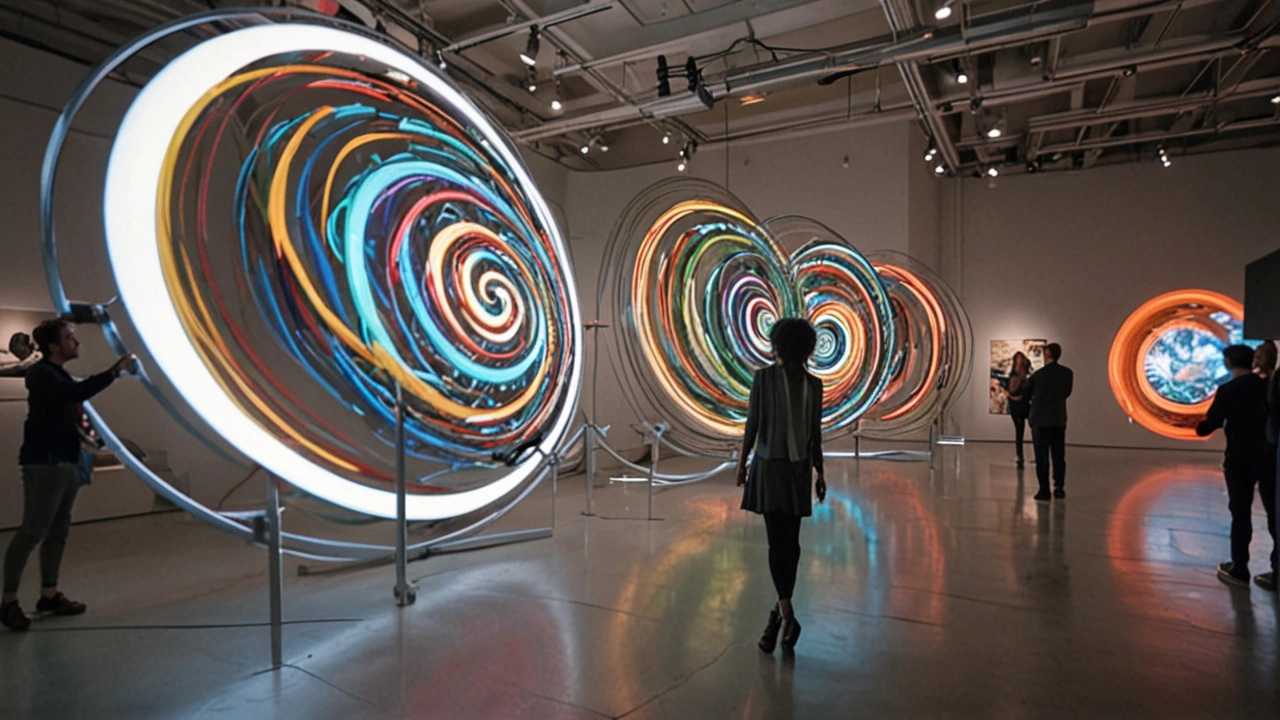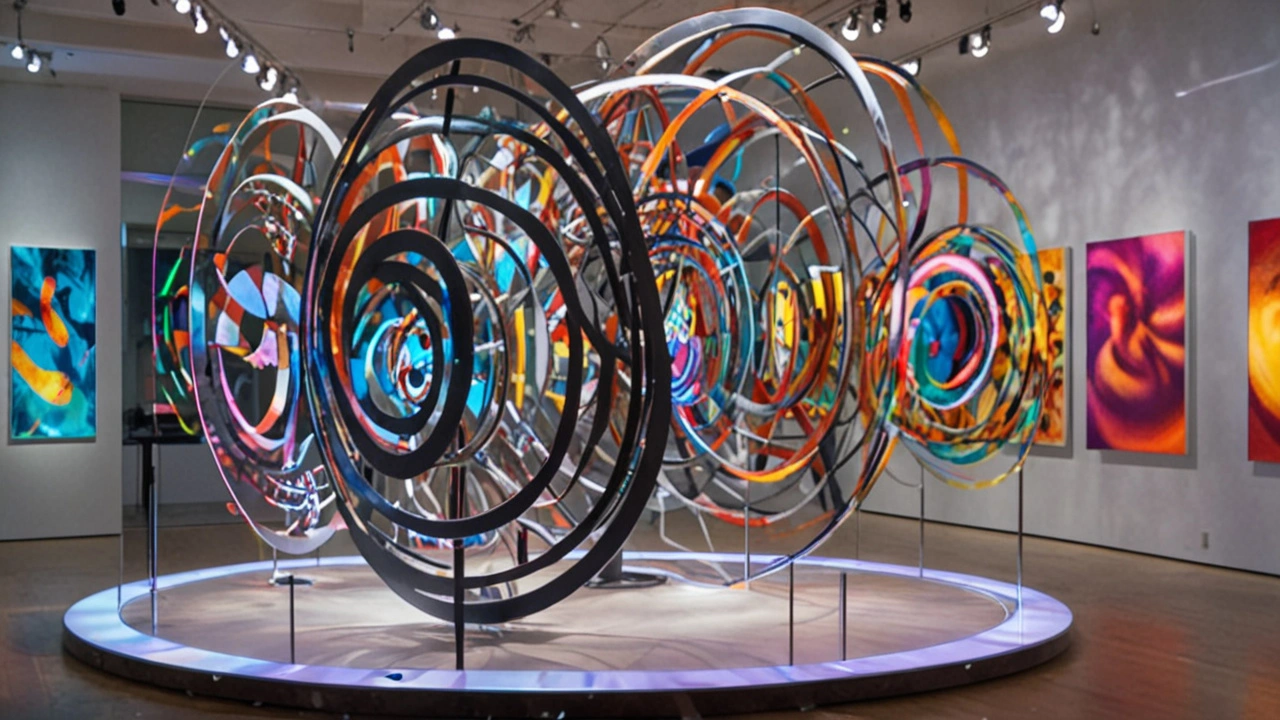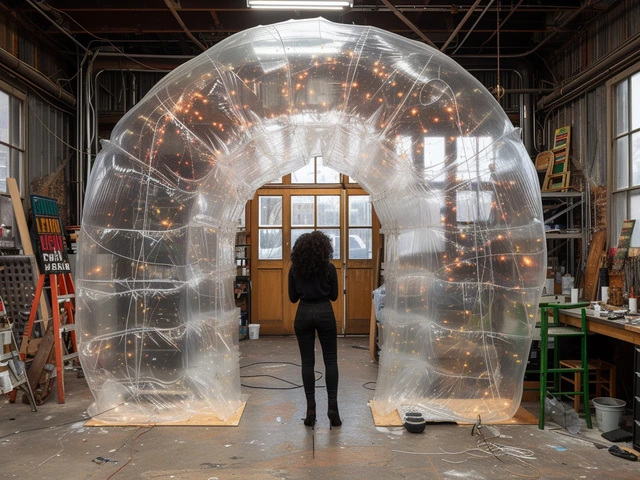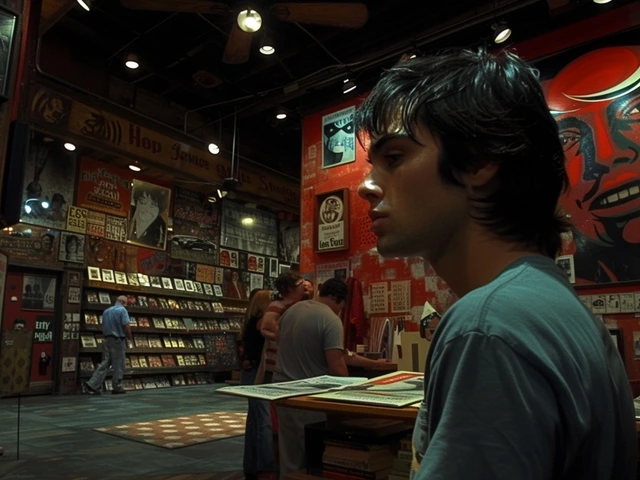Kinetic art stands out in the art world because it embraces movement to breathe life into creations. Unlike traditional static art, kinetic pieces engage audiences in a dynamic manner, inviting them to experience art in a whole new way.
The genre dates back to the early 20th century when artists started experimenting with motion. They wanted to break away from the confines of static images and sculptures. This innovation led to captivating works that move, spin, or light up, making them interactive and captivating.
Artists use various techniques and materials to bring kinetic art to life, from simple motors to complex electronic systems. Notable figures like Alexander Calder, famous for his mobiles, and Jean Tinguely, known for his mechanical sculptures, have paved the way for modern kinetic artists to explore new possibilities.
The impact of kinetic art on contemporary galleries is profound. It challenges conventional displays and creates immersive experiences that traditional art forms cannot. This evolution showcases the unending creativity and innovation within the art world.
Looking ahead, kinetic art will continue to evolve with advancements in technology, offering even more intricate and engaging works. This genre promises to keep pushing boundaries and inspiring both artists and audiences alike.
- Introduction to Kinetic Art
- Historical Background
- Techniques and Materials
- Notable Artists and Works
- Impact on Contemporary Art
- Future of Kinetic Art
Introduction to Kinetic Art
Kinetic art, by definition, is art that incorporates movement as part of its expression. This genre is unique because it challenges the traditional notion of art as a static, unchanging object. Instead, kinetic art pieces are dynamic and in a constant state of motion, either literally moving or giving the illusion of movement. The term itself originates from the Greek word 'kinesis,' meaning motion, and it aptly encapsulates the essence of this art form.
Though the concept of motion in art can be traced back to ancient times, the formalization of kinetic art began in the early 20th century. The industrial revolution and the advent of new technology fueled artists' imaginations, allowing them to experiment with movement in ways previously impossible. A seminal figure in this movement was Alexander Calder, an American sculptor whose kinetic sculptures, known as mobiles, were groundbreaking. Calder's work gracefully combined engineering with artistry, and his mobiles were delicate structures that moved with the air’s currents, producing ever-changing visual experiences.
Another influential artist was Jean Tinguely, a Swiss painter and sculptor who was fascinated by machines and mechanics. Tinguely's creations, often noisy and whimsical mechanical assemblies, highlighted the fusion of art and technology. His 1960 piece ‘Homage to New York’ is particularly noteworthy. It was an assemblage of interconnected machines designed to self-destruct, embodying the ephemerality and impermanence of kinetic art. This piece was ahead of its time, symbolizing the intersection of modern art, technology, and performance.
Kinetic art spans a wide range of techniques and materials. Artists may use wind, water, magnets, or even digital and interactive technologies to set their works in motion. One common technique involves the use of simple electric motors to create movement. For example, contemporary kinetic artist Theo Jansen has become known for his Strandbeests, large sculptures that walk powered by the wind. These creations blend art and engineering seamlessly, demonstrating the boundless possibilities within kinetic art.
The appeal of kinetic art lies in its interactivity and its ability to engage viewers on multiple sensory levels. Unlike traditional art forms, which are passively observed, kinetic art invites viewers to experience its movement. This interactive element is crucial because it creates a more immersive and memorable experience. As Nancy White writes in her book
“Art Moves: The World of Kinetic Art,”these works ‘transform the viewer from being a mere spectator to becoming an active participant in the art’s existence.’
Today, kinetic art continues to evolve, integrating modern technologies such as robotics, artificial intelligence, and augmented reality. These advancements open up new avenues for creativity and innovation, ensuring that kinetic art remains a vibrant and progressive genre. As artists push the boundaries of what is possible with movement, they continue to captivate audiences and redefine the relationship between art and the observer. The future of kinetic art promises to be as dynamic and exciting as its intricate, ever-changing present.
Historical Background
Kinetic art may seem like a modern invention, but its roots trace back to the early 20th century. This genre began to take shape as artists and innovators sought new ways to engage the viewer with motion. Unlike the static canvases and sculptures that defined previous eras, kinetic art aimed to revolutionize the way people experienced art.
One of the earliest pioneers of kinetic art was Hungarian constructivist László Moholy-Nagy. Born in 1895, he believed that art should be dynamic and interactive. His works often incorporated mechanical systems and lights, challenging the static nature of traditional art forms. Moholy-Nagy's 1922 piece 'Light-Space Modulator' is a classic example of early kinetic art, combining light, shadow, and movement in a mesmerizing spectacle.
At around the same time, Russian artist Alexander Rodchenko was also experimenting with movement in his art. Rodchenko's 'Spatial Constructions' aimed to break the two-dimensional plane, inviting viewers to move around and experience his work from different angles. These early efforts set the stage for subsequent innovations in the field of kinetic art.
The Influence of Futurism
The Futurist movement, originating in Italy in the early 20th century, further propelled kinetic art into the spotlight. Futurists like Umberto Boccioni focused on capturing motion and speed in their works. Although much of their art was two-dimensional, their fascination with dynamic movement laid important conceptual groundwork for kinetic art. Boccioni's sculptures, in particular, conveyed a sense of motion and progression, inspiring future kinetic artists to explore these themes more deeply.
Calder's Contribution
In the mid-20th century, American sculptor Alexander Calder revolutionized kinetic art with his invention of the mobile. These hanging sculptures, made of wire and metal, moved gracefully with the slightest air currents, creating a continuously evolving visual experience. Calder's work was not only visually captivating but also accessible and playful, broadening the audience for kinetic art. He is often quoted saying,
"Just as one can compose colors, or forms, so one can compose motions."
Mechanical Marvels
Post-World War II, kinetic art saw another surge, thanks in part to advancements in engineering and technology. Artists like Jean Tinguely began creating mechanical sculptures that fascinated and bemused audiences. Tinguely's notorious self-destructing art piece, 'Homage to New York,' created in 1960, was a chaotic blend of motors, gears, and sound. It aimed to critique the impermanence and self-destruction inherent in modern technology, adding an intellectual depth to kinetic art that hadn't been explored before.
The impact of these early pioneers continues to resonate in the art world today. Their tireless experimentation laid a robust foundation for contemporary kinetic artists. Their works, both historic and innovative, remind us that art has no bounds; it evolves and expands, much like the society it reflects. Kinetic art, with its emphasis on motion and interactivity, exemplifies the endless possibilities of creative expression.

Techniques and Materials
Kinetic art thrives on its ability to incorporate motion, making it essential to understand the techniques and materials that bring these creations to life. At the heart of kinetic art is the desire to break free from static forms and engage the viewer in a dynamic interaction. This section delves into the various methods and materials used to craft these awe-inspiring pieces.
A widely-known technique in kinetic art is the use of simple mechanical components such as gears, pulleys, and levers. These elements form the basis for many early kinetic sculptures. Artists like Alexander Calder, who is famous for his mobiles, utilized these basic mechanisms to create intricate, balanced structures that move gracefully with air currents. Calder’s work exemplifies how simplicity in design can yield profound visual impact.
Another pivotal technique involves the use of motors and electrical components. The introduction of electricity into kinetic art allowed for more complex and sustained movement. Jean Tinguely, a Swiss artist, is renowned for his playful and sometimes chaotic mechanical sculptures, made possible by intricate motorized systems. His pieces often feature repetitive movements, creating a sense of rhythm and continuity that captivates the audience.
According to art historian Jack Burnham, "Mechanical art...brings viewers into an encounter with a work's physical properties, engaging their curiosity and intellect in novel ways."
Recent advancements in technology have significantly expanded the toolkit for kinetic artists. Modern kinetic art frequently incorporates computer programming and robotics. Artists use microcontrollers and sensors to create responsive pieces that interact with their environment or the viewer. This has opened up endless possibilities for creating works that are not only visually stimulating but also interactive.
In addition to traditional metals and wires, a wide range of materials is now employed in kinetic art. Plastics, wood, and even recycled objects can be transformed into moving art pieces. The choice of material often adds another layer of meaning to the work. For instance, installations using recycled components may comment on environmental issues, blending aesthetics with activism.
Innovative Materials
One fascinating development in kinetic art is the use of light and projection. Artists are now experimenting with LED lights, lasers, and holography to add an extra dimension to their work. These elements can make kinetic sculptures appear to change shape and color, enhancing the sense of movement. Light-based kinetic art often plays with perception, making it a highly engaging form of contemporary art.
The integration of sound is another technique employed by kinetic artists. By incorporating audio components, artists create multisensory experiences. Sound can be synchronized with movement, adding rhythm and a new layer of complexity to the artwork. These multisensory elements often immerse viewers, making the experience memorable and impactful.
Different techniques and materials have made kinetic art a dynamic and ever-evolving genre. As technology continues to advance, the potential for innovation within this art form expands. Kinetic artists will keep on pushing boundaries, exploring new ways to capture and convey motion, ensuring kinetic art remains a thrilling and influential genre in the modern art world.
Notable Artists and Works
Kinetic art has been steered by some exceptionally creative minds who have not only contributed to its growth but also opened up new realms of possibilities within the genre. These pioneers have left an indelible mark on the world of contemporary art through their ingenious creations.
Alexander Calder is perhaps one of the most renowned figures in kinetic art, often credited with inventing the mobile. His works feature slender wires with delicately balanced forms that move subtly with air currents. Calder’s mobiles are an incredible fusion of engineering and art, creating a visual dance in the eyes of viewers. One of his famous works, “Lobster Trap and Fish Tail,” perfectly demonstrates his ability to transform the simplest of elements into mesmerizing motion-filled sculptures.
Another prominent name in kinetic art is Jean Tinguely. Tinguely's mechanical sculptures often appear as complex entanglements of gears and levers. These machines, which Tinguely humorously referred to as “meta-mechanics,” create captivating and unpredictable performances. His masterpiece, “Homage to New York,” was designed to self-destruct, making a bold statement on the transient nature of art and life itself. This pioneering piece pushed the boundaries and encouraged viewers to rethink their relationship with art.
The monumental works of George Rickey also stand out in the kinetic art domain. Unlike Calder, Rickey’s pieces operate with a more deliberate and slow kinetic motion, often achieved through perfectly engineered balance. His outdoor sculptures, such as “Three Squares Gyratory,” move gracefully in response to natural wind forces, creating a serene and almost meditative experience for the viewers. These works illustrate Rickey’s brilliance in combining physics and aesthetics.
In contemporary times, artists like Theo Jansen have continued to carry the torch of kinetic art. Jansen, a visionary in every sense, creates large-scale kinetic sculptures called “Strandbeests” that mimic walking with the aid of wind power. His creatures, built from lightweight materials such as PVC pipes, roam beaches autonomously, blurring the lines between art and engineering. As Jansen himself puts it, “The walls between art and engineering exist only in our minds.”
“I want to bring art and engineering together, to create something that has the beauty of art and the functionality of engineering.” — Theo Jansen
Beyond these key figures, many other artists have also made significant contributions to kinetic art. Nicholas Schöffer, for example, integrated cybernetics into his kinetic sculptures, rendering his works interactive and responsive to the environment. Takis, another groundbreaker, used magnets to create floating sculptures that defy gravity and provoke awe.
Kinetic art's prolific journey is marked by diverse techniques and materials. Each artist, with their unique vision, has expanded the horizons of what is possible within the genre. As technology advances, these innovative minds continue to inspire future generations, ensuring that kinetic art remains a lively and evolving field in the art world.

Impact on Contemporary Art
Kinetic art has carved out a special place in contemporary art galleries, creating waves with its unique approach to artistry. Unlike static pieces that simply hang on walls or stand in corners, kinetic art incorporates movement, making it an immersive and interactive experience for viewers. This dynamic nature changes the way people engage with art, inviting them to become a part of the piece rather than just observers.
Museums and galleries worldwide have started to recognize the power of kinetic art. Institutions like the Museum Tinguely in Basel, Switzerland dedicated specifically to kinetic artist Jean Tinguely, testify to its growing significance. These spaces are tailored to host kinetic exhibitions, and their popularity indicates an evolving public interest towards this art form. The impact of kinetic art is visible in the rising attendance figures and media coverage surrounding these exhibitions. People are intrigued by the blend of art and engineering, a combination that offers both aesthetic and intellectual stimulation.
One of the essential aspects of kinetic art is its ability to adapt and integrate with modern technology. Today's artists utilize digital tools, sensors, and computer programming to create pieces that respond to environmental changes. This integration not only attracts a tech-savvy audience but also pushes the boundaries of what art can be. For instance, Dutch artist Theo Jansen's Strandbeests, walking sculptures powered by wind, are prime examples of this blend. They roam beaches like living creatures, mesmerizing spectators with their lifelike motions.
The influence of kinetic art reaches beyond just galleries and museums. It has a growing presence in public spaces, offering a refreshing break from typical urban installations. Moving sculptures and interactive displays are popping up in parks and plazas, reaching a wider audience and making art accessible to everyone. These pieces often invite the public to interact with them, fostering a more personal connection with art. Cities like Chicago, with its "Crown Fountain" designed by Jaume Plensa, showcase how kinetic art can enhance community spaces.
"Kinetic art is not just a modern expression; it is a movement that reflects a deeper understanding of our relationship with space and technology." - Tim Marshall, art critic
The commercial art market has also felt the impact of kinetic art. Collectors and investors are increasingly interested in acquiring pieces that offer more than traditional art. The dynamic and often mesmerizing nature of kinetic sculptures makes them desirable not only for their beauty but also for their novelty and innovation. Auction houses report heightened interest and higher bids for kinetic artworks, signaling a strong market presence.
Kinetic art's impact also extends into the realm of education. Many art schools and universities now offer courses focused on kinetic and interactive art forms. This educational shift points to a growing recognition of the genre's importance and its potential to inspire future generations of artists. Students learn to blend art with engineering, gaining skills that are applicable in various creative and technical fields. This interdisciplinary approach equips them with a unique skill set favored in an increasingly digital world.
As we look to the future, kinetic art promises to keep evolving, driven by technological advancements and continuous creative exploration. Virtual reality, augmented reality, and other emerging technologies offer exciting opportunities for kinetic artists. These innovations can create even more engaging and interactive experiences, further blurring the lines between art and reality. The impact of kinetic art on contemporary art is profound and ongoing, marking it as a significant force in the art world.
Future of Kinetic Art
The future of kinetic art is as dynamic as the works themselves. As technology advances, kinetic artists are continually exploring new methods to integrate motion into their pieces. The advent of smart materials, which react to environmental changes such as light and temperature, opens countless possibilities for innovation. Imagine a sculpture that changes its shape based on the surrounding light or temperature, creating an ever-evolving piece of art.
Virtual Reality (VR) and Augmented Reality (AR) are also becoming significant players in the evolution of kinetic art. By merging physical movement with digital enhancements, artists can create immersive experiences that were previously unimaginable. Merging traditional kinetic pieces with VR can transform a gallery visit into a highly interactive and personalized experience. These technologies allow viewers to 'enter' the artwork and interact with it in ways that static art could never permit.
One exciting development is the use of AI to create responsive kinetic art. Artists are incorporating artificial intelligence to design sculptures that react to viewer movements or sounds. Imagine stepping into a room where a sculpture shifts its form or color in response to your presence. This level of interaction can make each viewer's experience uniquely personal, altering the relationship between art and observer.
Several artists are leading the charge in these new frontiers. Take for instance, the innovative work of teamLab, a collective using digital technology to create interactive installations that change in response to visitors. Their creations blur the lines between kinetic art and digital experiences, suggesting a future where these realms are tightly intertwined. They are an excellent example of how kinetic art can evolve with modern tech.
“Kinetic art has always challenged our perceptions, but with today's technology, we are now able to engage with art in unprecedented ways,” states renowned art critic, Jonathon Blackwood.
Public installations of kinetic art are also on the rise. Cities around the world are embracing large-scale kinetic sculptures in public spaces, which not only beautify urban environments but also engage community members in a shared experience of dynamic art. These installations often become landmarks, fostering a connection between the city's residents and the ever-changing art pieces.
Looking ahead, the students and emerging artists of today, who have grown up with a plethora of technological tools, are likely to push kinetic art even further. Educational institutions are incorporating courses specifically geared toward kinetic and interactive art forms, ensuring that the next generation of artists is well-equipped to carry the torch forward.
With the continuous integration of new technologies, the future of kinetic art is limitless. We're witnessing the dawn of a new era where art is not just seen, but experienced in a multitude of sensory ways. From responsive installations to digital hybrids, kinetic art is set to become even more central in shaping how we interact with and appreciate art. The possibilities are truly boundless, making it an exhilarating time for both creators and admirers of this dynamic art form.




